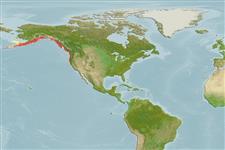>
Osmeriformes (Freshwater smelts) >
Osmeridae (Smelts)
Etymology: thaleichthys: thaleichthys meaning rich fish - referring to a high oil content (Ref. 1998).
More on author: Ayres.
Environment: milieu / climate zone / depth range / distribution range
Ekologi
laut; air tawar; payau bentopelagis; anadromus (ruaya dari laut ke air tawar) (Ref. 51243); kisaran kedalaman ? - 137 m (Ref. 6885). Temperate; 61°N - 38°N (Ref. 26213)
North Pacific: Prince William Sound, Alaska to Monterey Bay, California, USA. Landlocked in Washington and Union Lakes in Washington, USA.
Length at first maturity / Size / Weight / umur
Maturity: Lm 9.0 range ? - ? cm
Max length : 20.0 cm TL jantan/; (Ref. 27547); common length : 15.0 cm NG jantan/; (Ref. 27547); Umur maksimum dilaporkan: 3.00 Tahun (Ref. 12193)
Duri punggung (Keseluruhan (total)): 0; duri punggung lunak (Keseluruhan (total)): 8-10; Duri dubur 0; Sirip dubur lunak: 15 - 19; vertebrata, bertulang belakang: 55 - 61. Distinguished by its long upper jaw, which reaches at least below the middle of the eye in adults; the fine teeth in a single row on the vomer and palatine bones; and the 38 to 47 gill rakers on the 1st arch (Ref. 27547). Gill rakers long; lateral line incomplete and reaching not quite to below dorsal fin (Ref. 27547). Breeding males have tubercles on upper sides of paired fins (Ref. 27547). Pale olive brown dorsally, silvery white on sides and ventral surfaces; fins usually stripped along the rays, but inter-ray membranes clear;. Young are translucent with 2 rows of large black spots, on each side of the midline of the back, from head to caudal peduncle; peritoneum silver with light speckling. Spawning males with moss-green backs, and dense, black speckling on the head and dorsal surface of the body. The peritoneum is silvery with black speckling.
Found close to shore, in bays and estuaries and ascends coastal streams to spawn (Ref. 5723). There are landlocked populations (Ref. 5723) but these do not reach as great a size as sea-run fish (Ref. 27547). Anadromous (Ref. 96339). Individuals found in brackish and salt water feed on small crustaceans (Ref. 1998). Fish from the sea are reported to have good flavor, but supply is limited (Ref. 6885). Often abundant during the spawning run, but flesh reported to be soft and oily, easily spoiling (Ref. 1998).
Although most individuals die after spawning, some females apparently survive to age 3. It is not known whether or not these 3-year-olds spawned previously (Ref. 27547).
Page, L.M. and B.M. Burr, 1991. A field guide to freshwater fishes of North America north of Mexico. Houghton Mifflin Company, Boston. 432 p. (Ref. 5723)
Status IUCN Red List (Ref. 130435)
ancaman kepada manusia
Harmless
penggunaan manusia
Perikanan: perikanan swasembada
informasi lanjut
AcuanBudidaya airprofil budidaya airStrainGenetikaElectrophoresesDiturunkanPenyakit-penyakitPengolahanNutrientsMass conversion
mitraGambarStamps, Coins Misc.Suara-suaraCiguateraKecepatanTipe renangArea insangOtolithsOtakPenglihatan / visi
Alat, peralatan
laporan khas
muat turun XML
Sumber internet
Estimates based on models
Preferred temperature (Ref.
123201): 4.4 - 11.6, mean 8.4 °C (based on 196 cells).
Phylogenetic diversity index (Ref.
82804): PD
50 = 0.6250 [Uniqueness, from 0.5 = low to 2.0 = high].
Bayesian length-weight: a=0.00372 (0.00182 - 0.00758), b=3.17 (2.99 - 3.35), in cm total length, based on LWR estimates for this (Sub)family-body shape (Ref.
93245).
Trophic level (Ref.
69278): 3.2 ±0.35 se; based on food items.
Generation time: 2.6 ( na - na) years. Estimated as median ln(3)/K based on 1
growth studies.
Daya lenting (Ref.
120179): sedang, Waktu penggandaan populasi minimum 1.4 - 4.4 tahun (tm=2; tmax=3; K=0.43; Fec=535).
Fishing Vulnerability (Ref.
59153): Low to moderate vulnerability (28 of 100).
